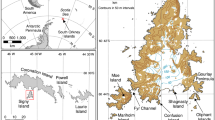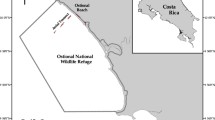Abstract
Aerial surveys are a valuable tool for monitoring wildlife and their habitats throughout North America, but manned aerial surveys for monitoring aquatic vegetation communities have seldom been evaluated rigorously. We used a fixed-wing aircraft and modified double observer method to survey an invasive aquatic macrophyte, water hyacinth (Eichhornia crassipes), and other floating-leaved aquatic vegetation along Illinois River to evaluate detection probability and error associated with size, extent, and species identification during aerial surveys. Generally, error rates for species identification (range = −3.7% − 1.0% mean error) and extent (\( \overset{-}{\boldsymbol{x}} \) = 2.2 ± 2.2% error) were low, but aerial estimates of bed size (\( \overset{-}{\boldsymbol{x}} \) = −0.65 ± 0.17 ha mean error) were less accurate. Aerial surveys were rapid (< 6 h/survey) and achieved reasonable estimates of species identification, species composition of beds, and bed size when beds were >0.04 ha. However, size estimates were much less accurate when beds were <0.04 ha. If precise spatial data are required, especially for small beds of aquatic vegetation, remote sensing technology and ground-surveillance may be better options than high-speed aerial surveys. However, census-style aerial surveys provide a cost-efficient and rapid technique for estimating coverage of large (>0.04 ha) beds and tracking occurrence of individual species of floating-leaved aquatic vegetation.




Similar content being viewed by others
References
Akaike H (1973) Maximum likelihood identification of Gaussian autoregressive moving average models. Biometrika 60:255–265
Albright TP, Moorhouse TG, McNabb TJ (2004) The rise and fall of water hyacinth in Lake Victoria and the Kagera River basin. J Aquat Plant Manag 42:73–84
Anderson K, Gaston KJ (2013) Lightweight unmanned aerial vehicles will revolutionize spatial ecology. Front Ecol Environ 11:138–146
Anderson SH, Gutzwiller KJ (1994) Habitat evaluation methods. In: Bookhout TA (ed) Research and management techniques for wildlife and habitats, 5th edn. The Wildlife Society, Maryland, pp 592–606
Angel J (2015) Illinois frost dates and growing season. Illinois State Water Survey, DIALOG http://www.isws.illinois.edu/atmos/statecli/frost/frost.htm. Accessed 1 Oct 2015
Anker Y, Hershkovitz Y, Ben Dor E, Gasith A (2014) Application of aerial digital photography for macrophyte cover and composition survey in small rural streams. River Res Appl 30(7):925–937
Bajer PG, Sullivan G, Sorensen PW (2009) Effects of a rapidly increasing population of common carp on vegetative cover and waterfowl in a recently restored Midwestern shallow lake. Hydrobiologia 632:235–245
Bear GD, White GC, Carpenter LH, Gill RB, Essex DJ (1987) Evaluation of aerial mark-resighting estimates of elk populations. J Wildl Manag 53:908–915
Bellrose FC (1941) Duck food plants of the Illinois River valley. Illinois Nat Hist Surv Bull 21:237–280
Boike J, Yoshikawa K (2003) Mapping of periglacial geomorphology using kite/balloon aerial photography. Permafr Periglac Process 14:81–85
Breedlove BW, Dennis WM (1983) The use of small format aerial photography in aquatic macrophyton sampling. ecological assessment of macrophyton: collection, use, and meaning of data. ASTM Spec Tech Publ 843:100–110
Burnham KP, Anderson DR (2002) Model selection and multimodel inference: a practical information-theoretic approach, 2nd edn. Springer, New York
Carbonneau PE, Piégay H (2012) Introduction: The growing use of imagery in fundamental and applied river sciences. In: Carbonneau PE, Piégay H (eds) Fluvial remote sensing for science and management. Wiley, Chichester, pp 1–18
Cook RD, Jacobson JO (1979) A design for estimating visibility bias in aerial surveys. Biometrics 35:735–742
Dardeau EA Jr (1983) Aerial survey techniques to map and monitor aquatic plant populations-four case studies. No. WES-TR-A-83-1. Army Engineer Waterways Experiment Station, Vicksburg
Everitt JH, Escobar DE, Alaniz MA, Davis MR, Richerson JV (1996) Using spatial information technologies to map Chinese tamarisk (Tamarix chinensis) infestations. Weed Sci 44:194–201
Everitt JH, Yang C, Escobar DE, Webster CF, Lonard RI, Davis MR (1999) Using remote sensing and spatial information technologies to detect and map two aquatic macrophytes. J Aquat Plant Manag 37:71–80
Ferguson RL, Wood LL (1990) Mapping submerged aquatic vegetation in North Carolina with conventional aerial photography. Fed Coast Wetland Mapp Prog 90:125–133
Fleming PJS, Tracey JP (2008) Some human, aircraft and animal factors affecting aerial surveys: how to enumerate animals from the air. Wildl Res 35:258–267
Flynn KF, Chapra SC (2014) Remote sensing of submerged aquatic vegetation in a shallow non-turbid river using an unmanned aerial vehicle. Remote Sens 6(12):12815–12836
Gasaway WC, DuBois SD, Reed DJ, Harbo SJ (1986) Estimating moose population parameters from aerial surveys. University of Alaska, Institute of Arctic Biology, Fairbanks
Guidice JH, Fieberg JR, Zicus MC, Rave DP, Wright RG (2010) Cost and precision functions for aerial quadrat surveys: a case study of ring-necked ducks in Minnesota. J Wildl Manag 74(2):342–349
Hathout S, Simpson J (1982) A vegetation survey of Netley marsh using color and color infra-red imagery. J Environ Manag 15:25–34
Havera SP (1999) Waterfowl of Illinois: status and management. Illinois Natural History Survey Special Publication 21, Urbana
Hestir EL, Khanna S, Andrew ME, Santos MJ, Viers JH, Greenberg JA, Rajapakse SS, Ustin SL (2008) Identification of invasive vegetation using hyperspectral remote sensing in the California Delta ecosystem. Remote Sens Environ 112:4034–4047
Hine CS, Hagy HM, Horath MM, Yetter AP, Smith RV, and Stafford JD (2016) Response of aquatic vegetation communities and other wetland cover types to floodplain restoration at Emiquon Preserve. Hydrobiologia: 1–13. doi:10.1007/s10750-016-2893-5
Jones GP, Pearlstine LG, Percival HF (2006) An assessment of small unmanned aerial vehicles for wildlife research. Wildl Soc Bull 34:750–758
Kaminski RM, Prince HH (1981) Dabbling duck and aquatic macroinvertebrate responses to manipulated wetland habitat. J Wildl Manag 45:1–15
Langrehr HA, Dukerschein JT (1998) Assessment of aerial photointerpretation for detecting submersed aquatic vegetation. No. 98-10. Wisconsin Department of Natural Resources, Onalaska Long Term Resource Monitoring Program Field Station, Onalaska
Lass LW, Prather TS, Glenn NF, Weber KT, Mundt JT, Pettingill J (2005) A review of remote sensing of invasive weeds and example of early detection of spotted knapweed (Centaurea maculosa) and babysbreath (Gypsophila paniculata) with a hyperspectral sensor. Weed Sci 53:242–251
LeResche RE, Rausch RA (1974) Accuracy and precision of aerial moose censusing. J Wildl Manag 38:175–182
Linchant J, Lisein J, Semeki J, Lejeune P, Vermeulen C (2015) Are unmanned aircraft systems (UASs) the future of wildlife monitoring? A review of accomplishments and challenges. Mammal Rev 45:239–252
Linz GM, Blixt DC, Bergman DL, Bleier WJ (1996) Response of ducks to glyphosate-induced habitat alterations in wetlands. Wetlands 16(1):38–44
Mack RN, Lonsdale WM (2002) Eradicating invasive plants: hard-won lessons for islands. In: Veitch CR, Clout MN (eds) Turning the tide: the eradication of invasive species. IUCN SSC Invasive Species Specialist Group, IUCN, Gland, Switzerland and Cambridge, pp 164–172
Marcus WA, Fonstad MA (2008) Optical remote mapping of rivers at sub-meter resolutions and watershed extents. Earth Surf Process Landf 33(1):4–24
Marcus WA, Fonstad MA, Legleiter CJ (2012) Management applications of optical remote sensing in the active river channel. In: Carbonneau PE, Piégay H (eds) Fluvial remote sensing for science and management. Wiley, Chichester, pp 19–41
Marshall TR, Lee PF (1994) Mapping aquatic macrophytes though digital image analysis of aerial photographs: an assessment. J Aquat Plant Manag 32:61–66
Moore KA, Orth RJ, Wilcox DJ (2009) Assessment of the abundance of submersed aquatic vegetation (SAV) communities in the Chesapeake Bay and its use in SAV management. P. 233–257 In. Remote Sensing and Geospatial Technologies for Coastal Ecosystem Assessment and Management. Springer Berlin Heidelberg, Germany
Nagelkerke NJD (1991) A note on a general definition of the coefficient of determination. Biometrika 78:691–692
O’Neal BJ, Stafford JD, Larkin RP (2012) Stopover duration of autumn- migrating dabbling ducks. J Wildl Manag 76:285–293
Pearse AT, Dinsmore SJ, Kaminski RM, Reinecke KJ (2008) Evaluation of an aerial survey to estimate abundance of wintering ducks in Mississippi. J Wildl Manag 72:1413–1419
Planer-Friedrich B, Becker J, Brimer B, Merkel BJ (2007) Low-cost aerial photography for high-resolution mapping of hydrothermal areas in Yellowstone National Park. Int J Remote Sens 29:1781–1794
Rehm EM, Baldassarre GA (2007) The influence of interspersion on marsh bird abundance in New York. Wilson J Ornithol 119(4):648–654
Schouten LSM, Leeuwen HJC, Bakker JGM, Twongo T (1999) Water hyacinth detection in Lake Victoria by means of satellite SAR. Report USP-2:98–28
Silva TSF, Costa MPF, Melack JM, Novo EMLM (2008) Remote sensing of aquatic vegetation theory and applications. Environ Monit Assess 140(1–3):131–145
Smith GW (1995) A critical review of the aerial and ground surveys of breeding waterfowl in North America. No. FWS-SR-5, Fish and Wildlife Service Office of Migratory Bird Management, Laurel
Smith LM, Haukos DA, Prather RM (2004) Avian response to vegetative pattern in playa wetlands during winter. Wildl Soc Bull 32(2):474–480
Stafford JD, Horath MM, Yetter AP, Hine CS, Havera SP (2007) Wetland use by mallards during spring and fall in the Illinois and Central Mississippi River valleys. Waterbirds 30:394–402
Stafford JD, Horath MM, Yetter AP, Smith RV, Hine CS (2010) Historical and contemporary characteristics and waterfowl use of Illinois River valley wetlands. Wetlands 30:565–576
Starrett WC, Fritz AW (1965) A biological investigation of the fishes of Lake Chautauqua, Illinois. Illinois Nat Hist Surv Bull 29:1–104
Talkington LM (1991) The Illinois River: working for our state. Illinois State Water Survey Miscellaneous Publication No. 128, Urbana
Tazik PP (1988) Des Plaines River long-term monitoring program: vegetation analysis and habitat characterization. Illinois Natural History Survey Aquatic Biology Section 88(5)
U.S. Army Corps of Engineers, Rock Island District (2012) Illinois Waterway Locks and Dams
VonBank JA, Hagy HM, Casper AF (2016) Energetic carrying capacity of riverine and connected wetlands of the upper Illinois River for fall-migrating waterfowl. Am Midl Nat 176(2):210–221
Acknowledgements
This research was funded by the Illinois Department of Natural Resources through the Great Lakes Restoration Act, the University of Illinois Urbana-Champaign, the Illinois Natural History Survey, and Western Illinois University. Aviation services were provided by M. Cruce of Cruce Aviation. We thank S. Jenkins, J. Lamer, and J. Pendleton for formatting and revisions of early drafts, and thank field assistants G. Fretueg, M. Larruer, and D. McClain.
Author information
Authors and Affiliations
Corresponding author
Rights and permissions
About this article
Cite this article
VonBank, J.A., Casper, A.F., Yetter, A.P. et al. Evaluating a Rapid Aerial Survey for Floating-Leaved Aquatic Vegetation. Wetlands 37, 753–762 (2017). https://doi.org/10.1007/s13157-017-0910-8
Received:
Accepted:
Published:
Issue Date:
DOI: https://doi.org/10.1007/s13157-017-0910-8




